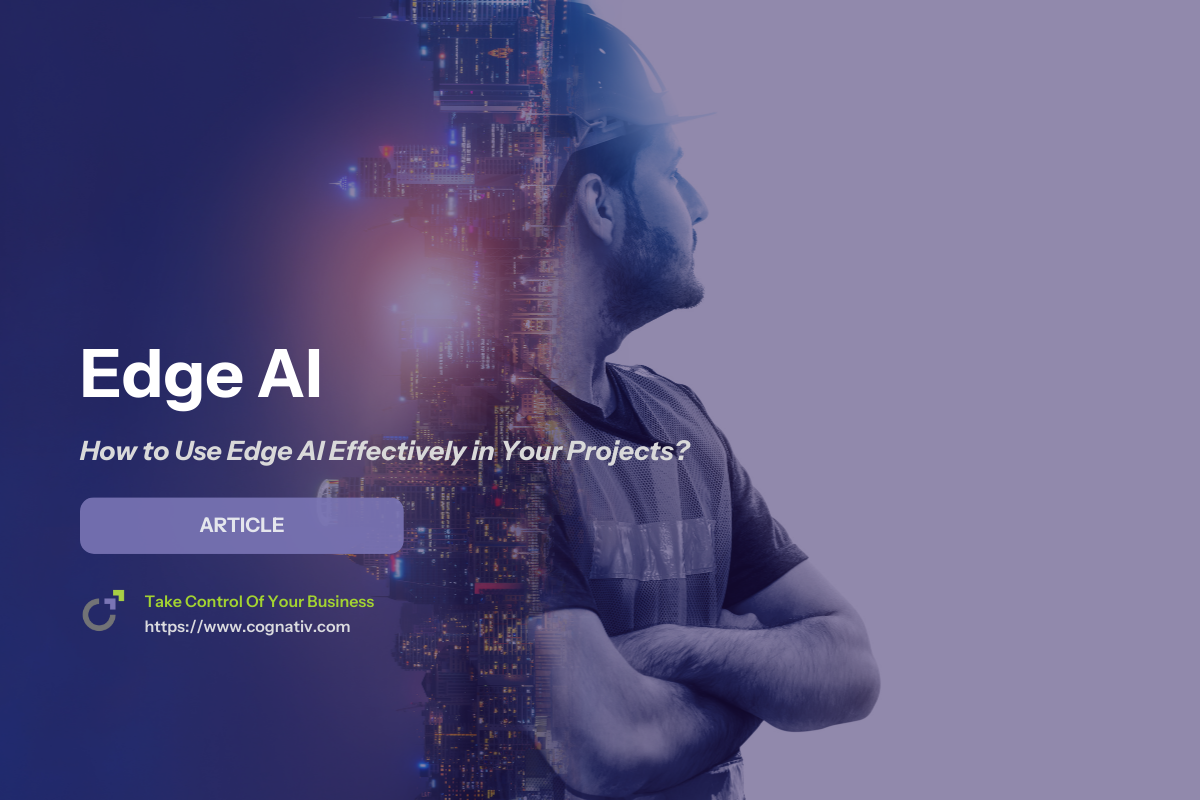How to Use Edge AI Effectively in Your Projects?
If you’re wondering how to use edge AI in your own projects, the first step is understanding what it is and why it matters.
Edge AI refers to deploying artificial intelligence (AI) and machine learning models directly on edge devices such as IoT sensors, cameras, and gateways — instead of relying entirely on cloud based infrastructure.
Unlike traditional AI, which processes data in remote servers or cloud servers, edge AI systems run AI models and AI algorithms where the data is generated. This enables:
Real time data processing for immediate insights.
Reduced bandwidth usage, since less data is transmitted back to a central location.
Improved enhanced privacy, because sensitive data doesn’t always leave the device.
Potential cost savings, since organizations avoid the overhead of constant uploads to the cloud.
In short, edge AI offers a balance of AI technology and edge computing to process information at the network edge while still leveraging the cloud resources when necessary.


Edge AI vs Traditional Approaches
To fully grasp edge AI’s capabilities, it helps to compare it with traditional AI:
Cloud based AI: Data is transmitted to cloud based systems, processed in centralized cloud data centers, and results are sent back.
Edge AI: Devices process data locally. By processing data locally, edge AI devices operate independently of constant cloud connectivity.
Key differences:
Latency → Edge AI’s ability to analyze and respond instantly beats the lag of waiting for data transmitted to the cloud.
Bandwidth usage → Less reliance on transmitting massive raw data streams.
Autonomy → Devices perform real time decision making without waiting for cloud resources.
Privacy → Fewer risks of exposing sensitive information by avoiding frequent uploads to remote servers.
This flexibility makes edge AI work far more practical for smart cities, autonomous vehicles, and industrial environments requiring real time monitoring.


How Edge AI Operates?
At its core, edge AI technology operates by combining:
AI models → Deployed after being trained on massive datasets.
Machine learning models & machine learning algorithms → Enable tasks like anomaly detection, defect detection, or quality control.
Edge devices (e.g., IoT devices, wearable devices, gateways, or even smart cameras).
Workflow:
AI processing happens directly on the device.
Sensor data is analyzed immediately, instead of being sent to the cloud.
Only the most relevant information may be sent to cloud computing platforms for aggregation or cloud AI-based model training.
Results are fed back into edge AI models, creating a loop of distributed AI across multiple devices.
This hybrid model lets organizations enjoy both the benefits of edge AI (speed, enhanced privacy) and the scale of cloud based systems.
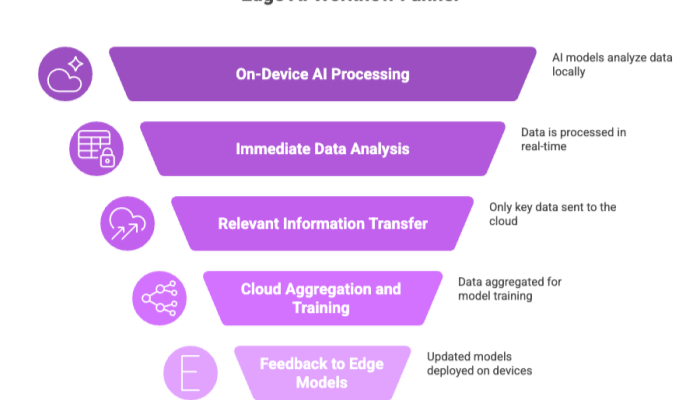

Edge AI Use Cases
The list of edge AI use cases continues to expand as industries see how valuable real time decision making can be.
Industrial automation:
Supply chain analytics and predictive maintenance using machine learning models running on edge devices.
Detecting defects in production lines using edge ai models.
Smart cities:
Managing traffic flow with edge AI work deployed in traffic lights and sensors.
Enhancing safety with connected security cameras and smart homes.
Autonomous vehicles:
Handling sensor data in milliseconds to make split second decisions.
Reducing dependence on cloud servers while still benefiting from cloud computing updates.
Healthcare:
Real time monitoring of patients with edge ai devices that flag anomalies instantly.
Protecting sensitive information by processing data locally instead of transmitting patient records.
Every edge AI application listed above demonstrates edge AI’s ability to improve business operations through speed, autonomy, and lower dependency on cloud based infrastructure.
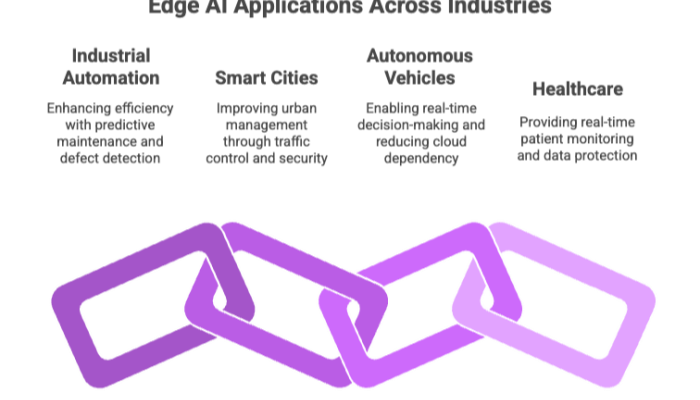

Security Considerations
With great autonomy comes new security challenges. Edge AI systems need robust security measures since they deal with sensitive data at the network edge.
Threats: Hacking, malware, and tampering with edge devices.
Data sovereignty regulations: Some regions require strict control over storing data locally, making edge AI devices a better fit than cloud based models.
Security protocols: Encryption, secure boot, and hardware-based authentication safeguard against attacks.
Regular updates: Keeping AI models, firmware, and optimized AI models patched reduces vulnerabilities.
Ultimately, integrating edge AI into projects requires balancing AI capabilities with security concerns. Protecting sensitive information is as critical as deploying innovative edge AI work.
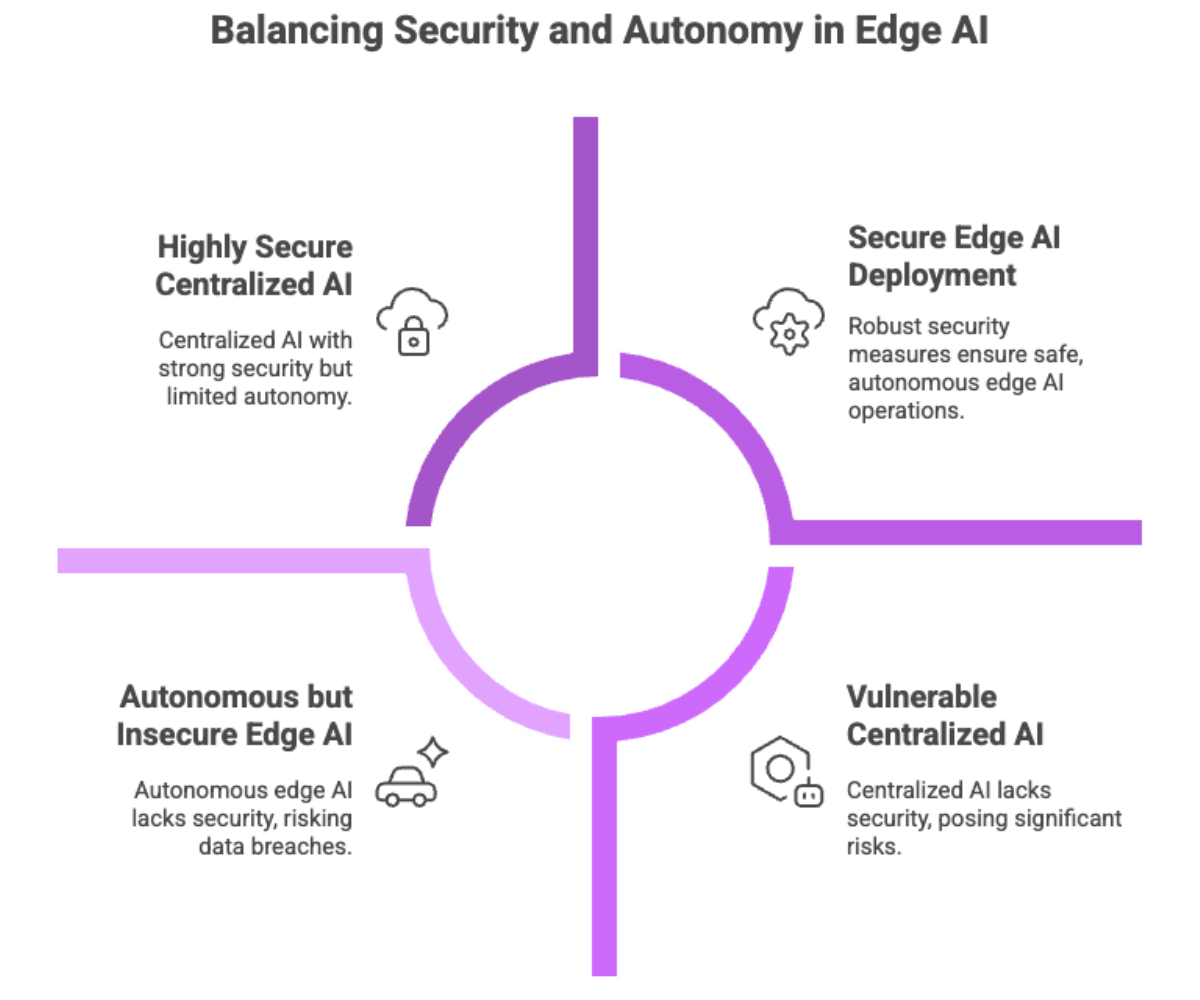

Energy Efficiency
One of the benefits of edge AI that is often overlooked is energy efficiency. Since edge ai devices perform ai processing closer to where data is generated, they minimize the constant back-and-forth of transmit data between remote servers and edge ai models.
This not only reduces bandwidth usage but also cuts down on power consumption, which can be a critical factor in smart cities or industries operating thousands of connected edge devices simultaneously.
How Energy Efficiency Is Achieved in Edge AI?
Optimized AI models: Smaller, streamlined models are deployed to ensure devices don’t need specialized hardware just to process information.
Processing data locally: Instead of transmitting raw data continuously to cloud servers, devices handle the most critical data on-site.
Low-power modes: Edge ai devices are engineered to scale their energy draw based on task complexity.
Distributed AI: By spreading workloads across multiple devices, energy demand is balanced instead of bottlenecked at a single point.
From wearable devices monitoring health metrics to industrial automation systems running machine learning models, energy optimization ensures system performance is reliable without unnecessary environmental impact.
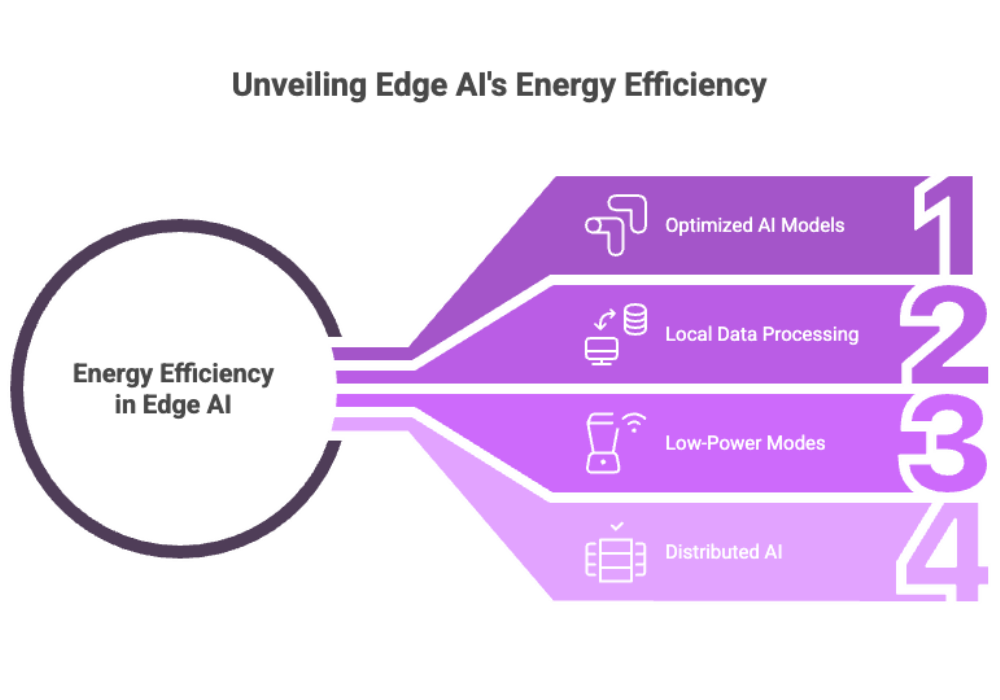

Future Developments
The future of edge AI is incredibly promising, driven by emerging technologies like 5G networks, deep learning, smart homes, and advanced edge ai hardware.
5G + Edge AI: Ultra-low latency makes real time responsiveness possible for autonomous vehicles or retail experiences.
Smarter AI algorithms: Techniques like fine tuning and deep learning allow ai models to handle complex problems more effectively, even with limited processing power.
Edge ai integration with cloud computing: Businesses can rely on cloud resources for model training and push edge ai work to devices for real time decision making.
Distributed AI ecosystems: Instead of depending solely on centralized systems, organizations will increasingly use edge ai capabilities spread across network edge devices.
This evolution not only makes edge ai application deployment more scalable but also keeps pace with global requirements for data sovereignty regulations, sensitive information protection, and cost savings.
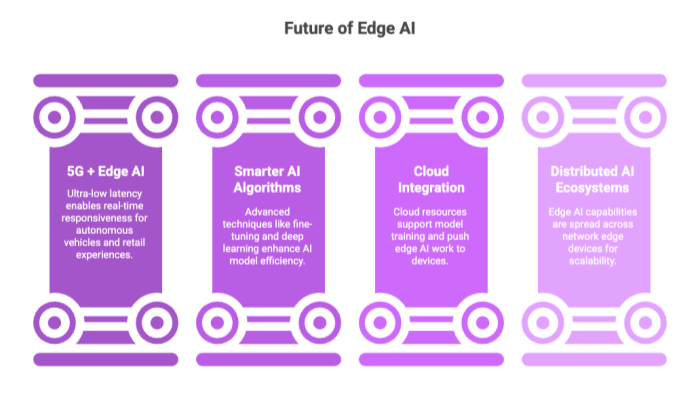

Best Practices for Implementation
Knowing how to use edge AI effectively requires careful planning and strategic integration. Businesses rushing to adopt edge ai technology often underestimate the balance required between cloud computing and edge ai systems.
Best Practices Checklist:
Start small: Deploy running ai models locally on a few iot devices before scaling to thousands.
Secure edge ai devices: Build with data privacy and security concerns in mind from day one.
Monitor continuously: Real time monitoring helps organizations detect when edge ai work drifts or ai models degrade.
Integrate edge AI with cloud computing: Use the cloud based systems for custom model training, while edge ai models handle processing data locally.
Optimize energy: Always deploy optimized ai models that consume less computational power without reducing system performance.
Document workflows: Ensure data scientists and engineers can track every update to machine learning models for compliance and business operations.
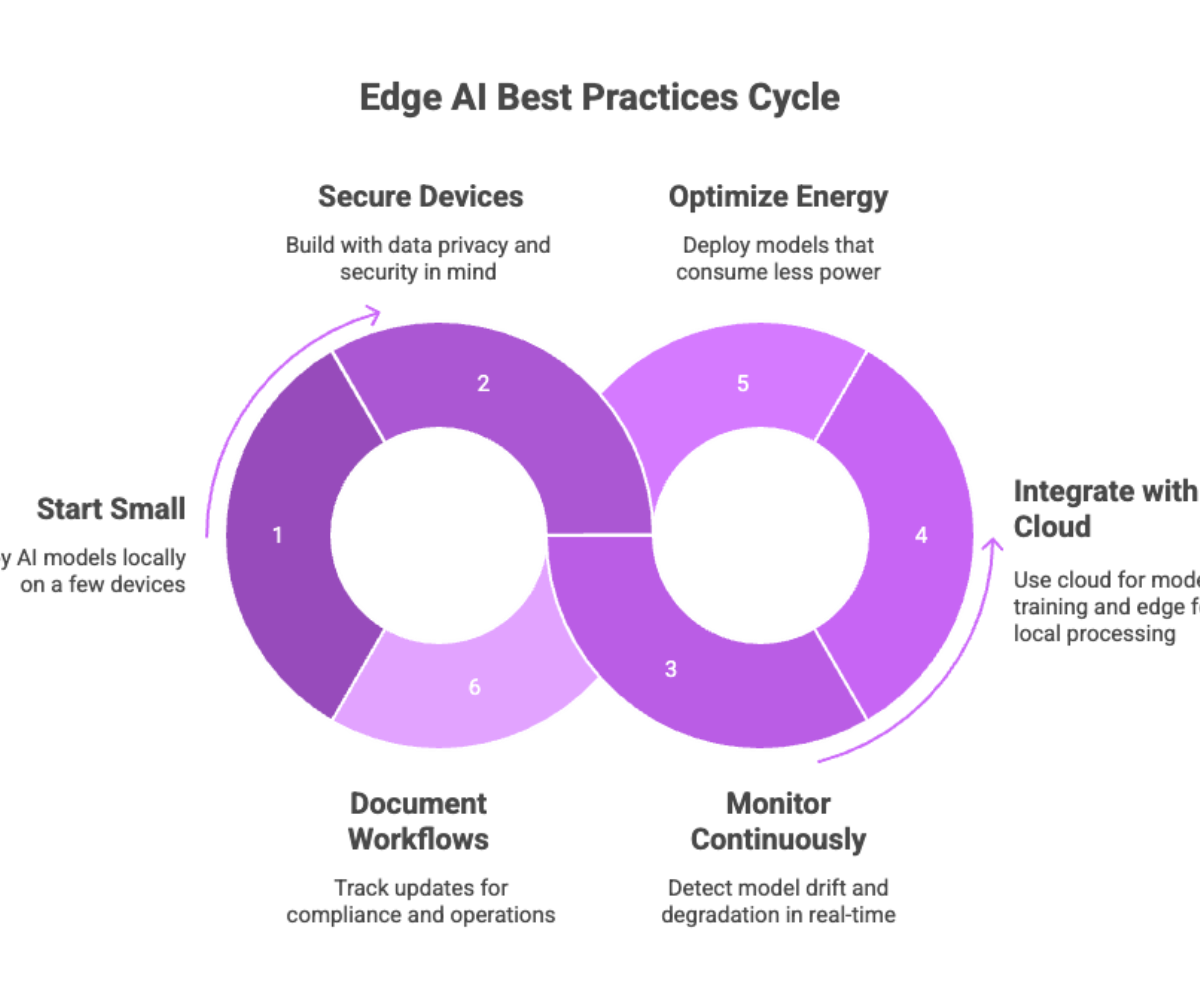

The Role of Edge AI in Digital Transformation
Finally, edge AI plays a central role in today’s digital transformation. Companies across industries are recognizing that cloud based AI alone cannot solve challenges requiring real time data processing.
Manufacturing: Edge ai offers predictive insights to improve worker safety and prevent downtime.
Healthcare: Edge ai devices reduce risks by handling sensitive data locally and enabling real time monitoring.
Finance: Fraud detection relies on edge ai models analyzing incoming data instantly instead of waiting for centralized cloud resources.
Smart cities: From traffic flow management to public safety, edge ai capabilities keep urban environments efficient.
The result is not just faster decision making but also stronger business operations, lower bandwidth costs, and better overall productivity.
Edge AI work is now inseparable from broader digital initiatives. It helps organizations optimize operations, adopt distributed AI, and prepare for a future where multiple devices work together seamlessly to deliver actionable insights.

